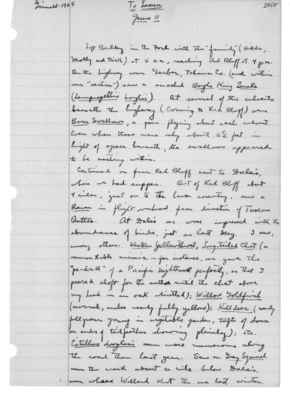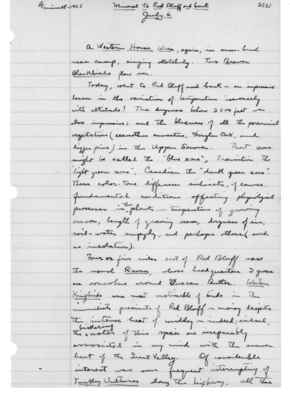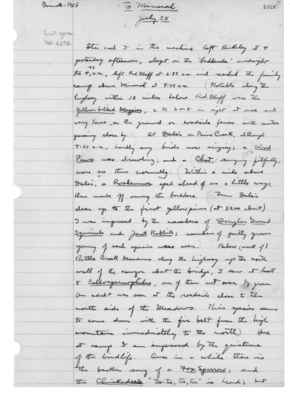Pages That Mention Red Bluff
1925: Joseph Grinnell's field notes
S2 Page 2
Collector: Grinnell - 1925 Location: Lassen Section Date: June 11, 1925 Page Number: 2458
Left Berkeley in the Ford with the "family" (Hilda, Molly and Dick) at 5 a.m., reaching Red Bluff at 4 p.m. on the highway near Gerber, Tehama Co. (and within our "section") saw a smashed Boyle King Snake (Lampropeltis boylii). At several of the culverts beneath the highway (Corning to Red Bluff) were Barn Swallows, a pair flying about each culvert. Even when these were only about 2 1/2 feet in height of space beneath, the swallows appeared to be nesting within. Continued on from Red Bluff east to Dale's, where we had supper. Out of Red Bluff about 4 miles, just on to the lava country, saw a Raven in flight overhead from direction of Tuscan Buttes. At Dale's we were impressed with the abundance of birds, just as last May. I saw, among others: Western Yellowthroat; Long-tailed Chat (a remarkable mimic - for instance, one gave the "pe-ark" of a Pacific nighthawk perfectly, so that I peered aloft for the author until the chat above my head in an oak whistled); Willow Goldfinch (several, males nearly fully yellow); Killdeer (nearly fullgrown young in vegetable garden, tufts of down on ends of tailfeathers showing plainly); etc. Citellus douglasi seem more numerous along the road than last year. Saw an Gray Squirrel near the creek about a mile below Dale's, near where Willard shot the one last winter.
S2 Page 68
Collector: Grinnell - 1925 Location: Mineral to Red Bluff and back Date: July 6 Page Number: 2521
A western House Wren, again, in snow-brush near camp, singing sketchily. Two Brewer Blackbirds flew over.
Today, went to Red Bluff and back - an impressive lesson in the variation of temperature inversely with altitude! The dryness below 3500 feet was also impressive; and the blueness of all the perennial vegetation (ceanothus cuneatus, Douglas Oak, and digger pine) in the Upper Sonoran. That zone might be called the "blue zone", Transition the "light green zone", Canadian the "dark green zone". These color-tone differences indicate, of course, fundamental conditions affecting physiological processes in ^the plants - temperature of growing season, length of growing season, dryness of air, soil-water supply, and perhaps others (such as insolation).
Four or five miles east of Red Bluff saw the usual Raven, whose headquarters I guess are somewhere around Tuscan Buttes. Western Kingbirds were most noticeable of birds in the immediate precincts of Red Bluff - noisy despite the intense heat of midday - indeed; indeed, the ^bickering notes of this species are inseparable, associated in my mind with the summer heat of the Great Valley. Of considerable interest was our frequent interrupting of Turkey Vultures along the highway, all the
S2 Page 69
Collector: Grinnell - 1925 Location: Red Bluff to ]]Mineral]] Date: July 6 Page Number: 2522
way from the edge of the yellow pines (3300 ft., about) to within the miles of Red Bluff. There is a great deal of "speeding" on this road, stretches of which are straight and finely surfaced. As a result, numbers of Jack Rabbits and Douglas Ground Squirrels are run down; and these "remains" form a quite dependable food source for the Turkey Vultures, which evidently patrol the highway regularly for these victims of the auto. The mammal bodies are, of course, as a rule conspicuous on the roadways, much more so than in the chaparral or on the lava "plains" elsewhere. This is a new manner of draft on the mammalian population; a carefully taken census over a given, average stretch of road-way, would be significant in this connection. There may have been compensation already, however; for example, last winter, I was told by one of the road men that he and others kept steel traps going, for coyotes, ^bob-cats, and foxes, the pelts of which are so valuable. I suppose that means a let-up on the draft of carnivores upon those vegetarians.
Our trip down and back was unfavorable to observing birds along the way. Mostly, when we were stopping, nothing was to be heard; the quiet season has arrived. The hearing of call-notes of Slender-billed Nuthatches
S2 Page 75
Collector: Grinnell - 1925 Location: To Mineral Date: July 25 Page Number: 2528
Last spec. no. 6292
Stu and I in the machine left Berkeley at 4 yesterday afternoon, slept on the "badlands" midnight to 4:45 a.m., left Red Bluff at 6:15 a.m. and reached the family camp above Mineral at 9:45 a.m. Notable along the highway within 12 miles below Red Bluff were the Yellow-billed Magpies, 2 to 6 or 8 in sight at once and very tame, on the ground or roadside fences with autos passing close by. At Dale's on Paine Creek, although 7:30 a.m., hardly any birds now singing; a Wood Pewee was drawling, and a Chat singing fitfully, more so than normally. Within a mile above Dale's, a Roadrunner sped ahead of us a little ways, then made off among the boulders. From Dale's clean up to the first yellow pines (at 3200 about) I was impressed by the numbers of Douglas Ground Squirrels and Jack Rabbits; numbers of partly grown young of each species were seen. Below (west of) Battle Creek Meadows along the highway up the north wall of the canyon about the bridge, I saw at least 8 Callospermophilus, one of them not over 1/3 grown. An adult was seen at the roadside close to the north side of the Meadows. This species seems to come down with the fir belt from the high mountain immediately to the north. Here at camp I am impressed by the quietness of the birdlife. Once in a while there is the broken song of a Fox Sparrow; and the Chickadee's "tee-tee, too, too" is heard; but



